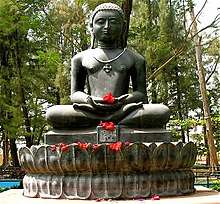Jainism in Goa
Jainism flourished in Goa during the rule of Kadamba dynasty.[1] Broken sculptures of the Jain Tirthankara Suparshvanatha, belonging to the period of the Goan Kadamba ruler Shivachitta Permadi Dev, were discovered in an old Jain temple in Jainkot, Naroa.[2]
| Part of a series on |
| Jainism |
|---|
 |
|
Jain prayers |
|
Ethics |
|
Major sects |
|
Texts |
|
Festivals
|
|
|
Muni Pranamsagar ji (Digambara Jain ascetic) visited Goa in 2015 and gained 150 new followers. It was the first time for a Jain ascetic to set foot in the state in a thousand years.[3][4] The state then became the place for his Chaturmas of the year 2015.[5]
Demographics
There were 864 Jains in Goa according to the 2001 census: 456 male and 408 female.[6] The number increased to 1,109 in 2011 census.[7]
History
Though Goa has a very modest population of Jains today, it was once a hub for the religious sect. The rich cultural heritage of this religion is slowly on its way to oblivion since the government has failed to make any planned efforts to protect it after Liberation. Korgao, Cudnem, Bandivade, Chandor, Cothambi, Naroa are places related with Jainism. All these villages are on river banks. Since ancient times, Goa has been one of the important centres of trade and commerce. During the Kadamba period, rulers rarely opposed other religions and cults and due to this, Jainism flourished.[2]
Chandrakant Bhoje Patil from Ponda says, “Once Goa had Jain settlements. The sculptures, temples, inscriptions found in various parts tell us how Jainism flourished here. Most of the vestiges of the Jain heritage are lying neglected now. We have submitted a memorandum recently (as noted in year 2014) to chief minister Manohar Parrikar to take steps for the protection and conservation of these assets of our history.”[2]
The ancient Jain temple of Cudnem village dedicated to Lord Rishabhanatha was constructed by Gurjara community in tenth century.[8][9] It went to ruins in fifteenth century. Broken idols of Tirthankara were discovered during an excavation in 1986 by the directorate of archeology and archives.[2]
Gurjara community also constructed the Jain temple at Narve, Bicholim in 1150 AD.[9] The sculpture of Parshvanatha, the 23rd Tirthankara was discovered in Hindolewada, Narve.[2]
Another ancient Jain temple of twenty-second Tirthankara Neminatha in Bandora, Goa built by King Sripala.[10][11]The Kannada inscription discovered in Bandivade of Ponda mentions that king Sripala established this village and built the Jain temple of Neminath which is presently in ruins.[2]
The idols of Tirthankara were also found in Chandreshwar temple in Kothambi village, situated on the right bank of the River Mandovi.Kothambi, here the sculptures of Kuber, Yakshi and the broken idol of Tirthankar were lying neglected. The idols of Yakshi and Kuber have been housed at the Goa state museum but the idol of Tirthankar is still (as noted on 2014) left unattended to fight the sunlight and rains.[2]
The first Jain sculpture (belonging to the early southern Shilahara Dynasty) in Salcete, Chandor was discovered by Father Henry Heras during one of his expeditions.[2]
Notes
- History of Goa, Department of Information and Publicity, Government of Goa, archived from the original on 4 March 2016, retrieved 14 September 2015
- Kerkar & TNN 2014.
- TNN (7 June 2015), Non-familiarity to Jain monks led to nude sadhu issue, Panaji: The Times of India
- Navhind Times (7 June 2015), Jain Mandal says awareness needs to be created on Digambar sect seers, Panaji: The Navhind Times, archived from the original on 23 December 2015, retrieved 14 September 2015
- TNN (9 April 2015), Netas’ comments on nude monk hurt Jain community, Margoa: The Times of India
- Census of India (2001), Population by religious communities, Ministry of Home Affairs (India), archived from the original on 1 July 2010, retrieved 14 September 2015
- Census of India (2011), Goa Population - Census India 2011, Ministry of Home Affairs (India), archived from the original on 29 January 2018, retrieved 20 November 2018
- Goa - Early recorded history (The Aryan conquest), Department of Tourism, Government of Goa, archived from the original on 10 September 2015, retrieved 14 September 2015
- de Souza 1989, p. 12.
- TNN (24 November 2008), Singular pre-Portuguese monument crumbling from neglect Paul Fernandes finds that the Jain basti at Bandora requires conservation, Goa: The Times of India, archived from the original on 5 March 2016, retrieved 20 November 2018
- Shenoy, Balaji (11 February 2015), Ruins of Neminath Jain Basti at Bandora, The Navhind Times, archived from the original on 8 March 2016, retrieved 18 September 2015
References
- Kerkar, Rajendra; TNN (31 October 2014), Jain heritage dwindles as govt sits pretty, The Times of India
- Kakar, Katarina (15 December 2013), Moving to Goa, Penguin UK
- de Souza, Teotonio R. (1 January 1994), Goa to Me, New Delhi: Concept Publishing Company, ISBN 81-7022-504-3
- de Souza, Teotonio R. (1 January 1989), Essays in Goan History, New Delhi: Concept Publishing Company, ISBN 81-7022-263-X
